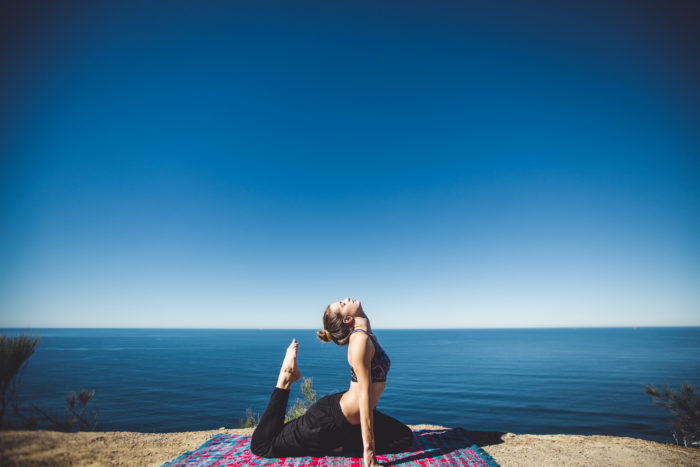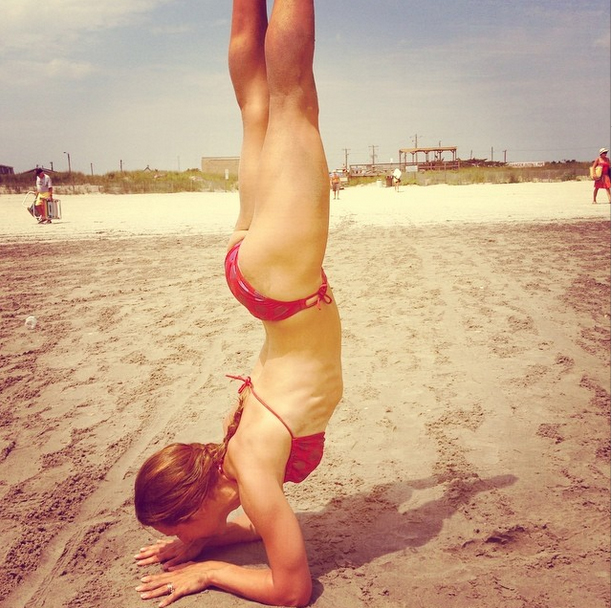
When I think of injury and yoga, a few unpleasant falls from handstand attempts come to mind. Just this past weekend, I was trying to gracefully hop into handstand, but one over-enthusiastic hop sent me falling over myself. I nearly came crashing down onto my cat who had hitherto been quietly enjoying a patch of sun. We were both a little shaken up.
But one of the reasons I pick myself up and try handstand again (and again) is because I sense that falling is the worst thing that can happen to me in handstand. That’s not to say that falling is without risks, but I’m willing to try to get better at handstand—and get better at falling in the process. I don’t have the same plucky attitude about all challenging yoga poses, however. In fact, there are several that I simply avoid.
When It’s More than Your Hamstrings
The past decade or so has revealed that yoga, contrary to its public image as a source of universal healing and balance, has some shocking hidden risks. Sure, we yogis run into strains, bruises, and sometimes the unlucky sprain—but what athletic activity doesn’t come with those mild yet unpleasant side effects? (We’ve probably all dealt with unhappy hamstrings at some point or another.) But as it turns out, soreness here and there is just the tip of the iceberg.
Fractures, dislocations, bulging discs, and even stroke are among yoga’s more concerning risks—and these risks aren’t something many in the yoga community feel comfortable addressing especially since these dangers are associated with some of yoga’s most beloved poses.
When William J. Broad published The Science of Yoga: The Risks and The Rewards in 2012, he experienced backlash for exploring the risks of more serious injuries including strokes. In a related article for the New York Times, Broad highlights that poses in which the neck is compressed, sharply bent, or overextended present the risk for nerve damage, which could lead to mild, temporary symptoms as well as more serious, permanent damage. In particular, headstand, shoulder stand, and deep spinal twists (in which the neck is overextended to one side) can deprive nerves of oxygen for extended periods of time while also putting vertebrae in a vulnerable position.
The results from more serious nerve injuries can be tragic and life-altering. In one case of yoga-related brain injury, a 34-year-old woman had been in headstand for five minutes, after which she felt a sharp pain in her neck, and her right hand became numb. As time passed, and the woman underwent multiple doctor visits, her pain worsened, and she experienced paralysis on her left side accompanied by nausea and headaches. Ultimately, a medical team diagnosed severe blockage in the basilar artery, which was cutting off blood supply to her inner brain. After intensive therapy, she recovered some control over the left side of her body, but still experienced some difficulty using her left hand. Some would consider this woman lucky, however. Up to 4% of yoga stroke cases result in death.
Letting Go of Ego and Reducing the Risk of Injury
Glenn Black, yoga instructor to the financially endowed, explains that some injuries occur when ego takes the wheel (no asana pun intended). If a yogi is showing off (to others or to himself), he’s pushing himself rather than being mindful—but yoga is all about cultivating mindfulness and letting go of the ego, of course. Black explains that it’s important to always allow yourself a “release valve;” keep a micro-bend in your joints, and emphasize awareness over perfected poses.
But Ego Isn’t Behind All Injuries
Sometimes injury occurs when ego isn’t at play. Indeed, it can occur during seemingly innocuous poses that most would agree were suitable for beginner yogis. For example, cobra and upward-facing dog, two fairly simple backbends, present the opportunity for overextending the neck. As much as “listening to your body” is sound advice, there are occasions when the body feels wonderful in a certain pose, and it’s only later that we realize we may have pushed things a bit too far.
This is why it’s important to practice yoga–even the milder poses–with a special awareness of the neck and spine. As I mentioned above, there are certain yoga poses that I skip for this reason. Shoulder stand is one of them–even though it’s a pose I had always enjoyed (and I read that it’s anti-aging!). After I learned to be more aware of my neck, however, the pose simply seemed too constricting, and I didn’t want to risk it. Of course, there are health-conscious modifications that can be made to all poses with potential risks. In headstand, for example, practitioners can mindfully transfer the majority of their weight to their hands, resting minimal weight on the crown of the head. When I’m practicing by myself and not in the presence of an experienced teacher to help me with these modifications, however, I just give certain neck positions a pass.
Ultimately, the choice to practice certain poses is yours. This article simply asks that you take extra care of the vertebrae, nerves, and grey matter that work together to make the special yogi that you are.
What are your strategies for avoiding yoga injuries? Do you skip certain poses, or do you know any handy modifications?
More in Peaceful Practice: Treating and Preventing Yoga Wrist Pain
Safely Practicing Yoga While Pregnant
Related: Mindfully Healing an Injury with Ashtanga Yoga
Get more like this–sign up for our newsletter for exclusive inspirational content!
__
Photo: Matthew Kane via Unsplash




